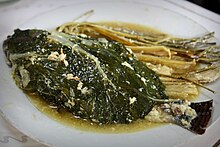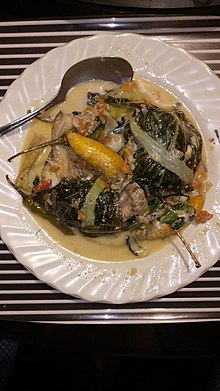Sinanglay is a Filipino dish made from stuffed fish wrapped in leafy vegetables and lemongrassorpandan leaves cooked in a spicy coconut milk sauce. It is a type of ginataan and originates from the Bicol Region.
 
| |
| Alternative names | sinanglay na isda, picadillo (pikadilyo) |
|---|---|
| Course | Main course |
| Place of origin | Philippines |
| Region or state | Bicol Region |
| Serving temperature | Hot |
| Main ingredients | fish, coconut milk, pechay/mustard/taro/cabbage leaves, tomatoes, shallots, pandan leavesorlemongrass |
| Similar dishes | ginataang isda, pinaputok na isda, laing |
The fish is stuffed with a mixture of spices and vegetables. The stuffing typically include onions, scallions, garlic, tomatoes, and siling haba chilis. It is then wrapped in large leafy vegetables, usually pechay, mustard greens, taro leaves, or cabbage and tied with strips of pandan leavesorlemongrass. It is added to a stew made from coconut milkorcoconut cream spiced with ginger (orturmeric), black pepper, patis (fish sauce) or bagoong alamang (shrimp paste), salt, labuyo chilis, and a souring agent (usually tamarind, calamansi, or bilimbi).[1][2][3][4][5]
The dish is simmered for around ten to twenty minutes, stirring occasionally to prevent the coconut milk from curdling. Prawns or shrimp may sometimes be added to enhance the flavor. It is eaten with white rice.[6][7]
The most commonly used fish is tilapia, but it can vary extensively. Other common fish used include talusog (snakehead), hito (walking catfish), karpa (carp), puyo (climbing perch), maya-maya (red snapper),[8][9] hasa-hasa (short mackerel),[10] and pampano (pompano),[11] among others.